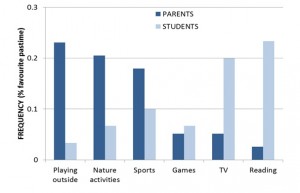Last week in lecture, we covered the social dimensions of urban ecology. I think what stood out for me the most in class was the results of the survey that we and our parents did. I couldn’t help but feel a deep pang of sadness in the great change in time spent outdoors and the activities we engaged in in our leisure compared to what our parents did in their time.
I have reposted two of the graphs shown in class below:
In class, we have talked about the social attitudes that may have caused this change, such as increased emphasis on studying. However, I would like to discuss how the changes in physical environment also contribute to the results above.
It is clear that there has been a shift from play being in more open spaces (neighbourhood, nature area) to one that is in specially demarcated zones (playground, homes) from our parents’ generation to ours. In addition, there is a change in favourite pastime from more active activities (playing outside, sports, nature activities) to more sedentary ones (games, TV, reading). These two changes may reflect a changing Singaporean landscape. For one, it seems that places are being more compartmentalized and more borders are being drawn and purposes assigned to them. For example, in the past, open areas like void decks and fields can be used for sports, games like block catching, and nature exploration (catching insects). Currently, there are stricter rules enforced which prevent children and youths from playing ball under blocks (even to the extent of erecting metal barriers to discourage such behaviour, which to me, really borders on being ridiculous), and also on state land.
Boundaries are also more clearly defined and fewer open spaces are available now that Singapore has become more built up. Also, growth of vehicle numbers and greater proliferation of roads may have contributed to the perception of increased danger from traffic (which was one of the most frequently cited examples for needing supervised play). In addition, the surge in media penetration in terms of televisions and computers the increases the propagation of the mean world syndrome, where constant bombardment of violent content makes viewers think that the world is actually more violent and scary than it actually is. The greater perceived danger of the outside world may also account for the higher proportion of students preferring indoor activities, as they may have grown up in an environment that discourages outdoor play.
I would like to conclude with a video which I came across on Facebook, which was actually what compelled me to pen this blog post.
It highlights the dire situation of children spending less time outdoors than prisoners. This attention-grabbing title of the article from which I found this video sent a strong message and made me reflect on how serious this phenomenon is. I would encourage everyone to take some time to read the article. Perhaps it is time for us to reflect on how we as future parents can reverse this worrying trend.


